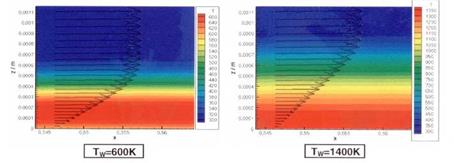Boundary-Layer Thickness at a Heated Wall
The supersonic laminar viscous boundary-layer flow past a flat plate was computed for two different constant wall temperatures [4]. The Navier-Stokes equations were employed, perfect gas was assumed. The flow parameters are given in Table 10.2. Note that the lower wall temperature is below the recovery temperature Tr, hence the boundary layer is cooled (heat flux into the wall). At the higher wall temperature the situation is reverted.
Results of the computations are given in Fig. 10.1. Shown are the tangential velocity profiles and the static temperatures, the latter with different color bars.
|
Table 10.2. Parameters of the perfect-gas flat-plate case with two wall temperatures [4].
|
|
Fig. 10.1. Tangential velocity profiles and static temperature distributions at a flat plate with two different wall temperatures [4]. Note the different color bar scales, z is the coordinate normal to the wall. |
We find several effects in the figure:
— According to eq. (10.4), the larger wall temperature (right) leads to a decrease of the average density < p > compared to the case with smaller wall temperature (left).
— If the same mass flow is present, the boundary-layer thickness S as well as the displacement thickness Si are larger in the case of the larger wall temperature. In fact S is two times larger with the hotter wall.
— For the lower wall temperature the velocity profile is full like a Blasius profile (left). With dT/dygw < 0 (heating of the boundary layer)—according to the wall compatibility condition—for the higher wall temperature a weak point of inflection is discernable at about z = 0.0001 m (right).
— The velocity gradient du/dzw is smaller for the hotter than for the cooler wall. Although the viscosity pw is increased, the skin friction tw is smaller for the hotter wall.
— Because of the smaller average density in the case of the hotter wall, also the average tangential momentum flux < pu2 > is reduced. If an adverse pressure gradient would be present, the boundary layer would be more at risk to separate. This is corroborated by the presence of the weak point of inflection.












